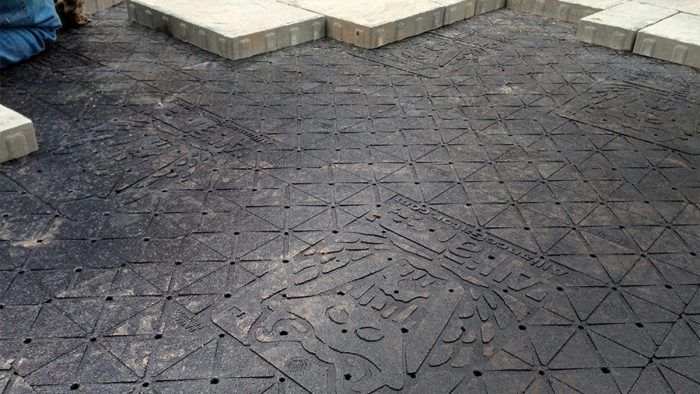Alternative Patio Base
Made of high-density foam, interlocking paver-base panels provide a stable base for concrete pavers without the need to lug several tons of gravel to the site.

Despite the joists being half-buried in the ground, our grade-level deck has managed to last more than a couple of decades. A patio replacement sounds appealing, but this is a townhouse, and we can’t get an excavator or truck in there to remove soil or bring in the stone for the base, and there’s no room to build up—it’s already nearly level with the interior floor. We’d like to replace what’s there with an eye toward increased longevity. We were thinking of digging down a few inches by hand, then laying down landscape fabric and some crushed stone, installing new 2x PT joists, and topping it with composite decking. Do you think we could get another 20 years or more out of that assembly?
—Peter Eggers via email
Tony Blue, owner of Squared Away Contracting (@squaredawaycontracting) in Greenwich, N.Y., responds: The primary concern with another ground-level deck is the new pressure-treated lumber: Like your grandfather would say, it just isn’t what it used to be. The preservatives used in today’s residential-grade PT lumber aren’t as good at resisting decay as the old stuff, so the wood rots more quickly. And not all composite decking is equal, either—some products require lots of airflow to avoid becoming a breeding ground for mushrooms, and some can’t be used on decks that aren’t firmly anchored to ground footings and/or the building. Unlike wood, composite decking tends to be a bit floppy. As you noted, though, townhouses often don’t allow access for heavy equipment without damaging neighboring properties.
With all this in mind, I’d recommend concrete pavers, which can be brought around the back of the property in a wheelbarrow. The standard patio base you know of— 6 in. of compacted gravel—can amount to several tons of material that would have to be moved without a truck. There’s a smarter way to accomplish this.
A handful of manufacturers make paver-base products out of high-density foam panels that lock together. They take the place of the gravel to provide a stable base for the pavers, but they’re light enough to carry around the house in your arms—in one trip for a modest-size patio. Gator Base is one I’ve installed, and it works well. It has built-in channels for drainage and is frost resistant. For the most part, the process is the same as a traditional paver installation, except for the substitution of the stone base.
First, excavate the top layer of soil by shovel and rake as needed. In your case, after removing the old deck, the area should already be free of vegetation, and it should be easy to move the soil. Use a laser level or stringline to pitch the area away from the house. Then use a plate compactor to tamp the soil firm and flat. A layer of drainable geotextile landscape fabric goes on top of that, followed by 3/4 in. of screeded and compacted sand. The Gator Base panels come next, and lock together with a tongue-and- groove system. Although not in the instructions, I’ve found that tamping again at this stage helps even everything out. Then install the pavers, followed by plastic edging. After filling the joints between the pavers with polymeric sand, compact the whole thing one more time and wet the area to activate the sand. This doesn’t eliminate all the heavy moving, but it’s a practical way to get an affordable patio without ruining your back or the neighbors’ lawns.
From Fine Homebuilding #290
Fine Homebuilding Recommended Products
Fine Homebuilding receives a commission for items purchased through links on this site, including Amazon Associates and other affiliate advertising programs.

Cepco BoWrench Decking Tool

Flashing and Joist Tape

Metal Connector Nailer





